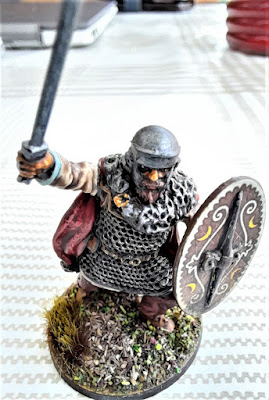This has to be the final new project of 2020!
When I look back on 2020, even more remarkable than the Global Pandemic, will be the number of new gaming projects I have started. True, not all of them are completely new, some of them are continuations of previous projects, like the starting of a German grenadier platoon for Chain of Command; this was a response to the possibility that I would only ever get to play solo games and would need some opposition for my Soviets.
I've been looking at Mortal Gods ever since I started visiting the Footsore Miniatures web site to buy figures for my Dux Britanniarum Irish Raiders project. Bad form that really... I think wargame related web sites should have some kind of filter that only allows you to look at the products that you have gone on to look at. Those of us who suffer from Wandering-to-other-sfuffitus don't need the temptation of nicely laid out buttons, that only have to be clicked upon to take us into a whole new world of figure enticement and the resultant cash outlay.
In the case of Mortal Gods, the subliminal seed has been slumbering airily since the late 1960s and only needed a bright shiny rule book with pictures of Hoplites and the words "skirmish games" printed boldly on the front cover to awaken the sleeping impulse to click on those seductive buttons containing the words "Add to Basket". The legacy of Ray Harryhausen and his clickety-clicking skeleton warriors, springing up from the teeth of the Hydra, has been fulfilled fifty years later in the form of the Mortal Gods Core Box Set and yet more unfinished projects confined to the ever-growing "to be completed at a later date" cupboard.
Of course, as a serious historical gamer, my original announced intention was to paint proper Greek warriors and fight proper skirmishes between Athenians and Spartans set in the serious historical strife of the Peloponnesian Wars. Wargamers are experts in Orwellian Doublethink and have no difficulty whatsoever believing that they are only going to play historical games while they click on the Pay Pal button to purchase a box of Wargames Atlantic skeletons and a set of Hades Faction Cards.
So far, I've started painting some hoplites in linothorax body armour from a Victrix Miniatures Athenian Warriors set that I bought at Partizan years ago, but I don't want to have very many of these, so the half dozen I have done will probably be enough. What I really want to focus on (apart from the skeletons) are the more lightly attired figures, so I'm now doing some un-armoured hoplites and I have a bundle of sprues with slingers, peltasts and archers waiting in the wings ready to build.Of course, one of the issues with hoplite figures is that you spend ages meticulously painting the linothorax and then you stick that great big shield on and you can't see any of the painstaking work you have done. At least when you are commanding your troops on the table top, you get the see the work you did on the back.
The shield designs on these figures come from the set produced by Battle Flag. I decided to use these, partly because I already had some, and partly because they are waterslide transfers and I was a little concerned about getting a good result when applying a transfer to the significant dome of a hoplite shield. Waterslide transfers do work very well when you use Micro Sol to soften them and, as they dry, they conform nicely to the shape of the shield. As I was buying some LBMS transfers for the light infantry figures, I decided to buy a single set for the hoplites, just to see how well they worked and, to be honest, they are absolutely superb. Just like the waterslide transfers, if you apply a coat of Micro Sol to the surface of the shield before you stick the LBMS decals into place, they conform to the domed surface brilliantly and they just look far superior to the waterslide transfers. Most of the waterslide transfers have needed touching up here and there and you have to work them quite hard to get them to sit flat without overlaps where the transfer meets the rim of the shield. Work them too hard however and that is where some of the print wears away and you need to touch them up with an application of paint. At £9 for 50 Battle Flag transfers, you can't complain at the value, but I think I might just acquire a few more LBMS decals, just to add to the variety you understand!
The Victrix hoplite miniatures are great fun, if a little time consuming, to paint. But I'm really looking forward to having a go at the lighter troops as well.
Some of the casting on these figures is a bit blocky, particularly the sword scabbards, but they are full of the usual Victrix character. More of these to work on over Christmas, both as hoplites and peltasts.





















































